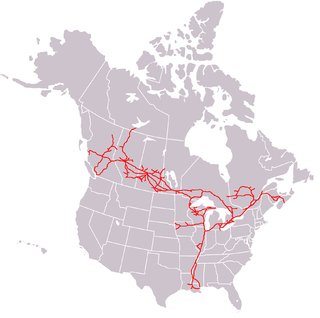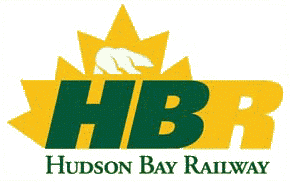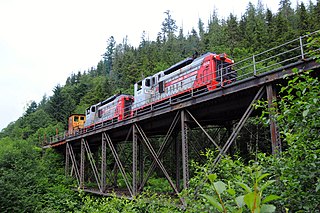The Ponton train derailment, near Ponton, Manitoba on September 15, 2018, fatally injured train conductor Kevin Anderson, injured the train's engineer, and triggered a spill of diesel fuel. [1]
The Ponton train derailment, near Ponton, Manitoba on September 15, 2018, fatally injured train conductor Kevin Anderson, injured the train's engineer, and triggered a spill of diesel fuel. [1]
The train was pulled by 3 locomotives, and contained "several dozen" tanker cars, loaded with "liquid petroleum". [2] Initially Arctic Gateway Group reported that no oil had been spilled. [3] On September 19 Global News described the train's cargo in greater detail, stating it included gasoline, liquid propane gas and butane. [4] Global reported that while none of the cargo had been spilled rail workers were trying to contain diesel fuel that was leaking from the locomotives.
The train was crossing the Metishto River, when it derailed. [5] Accounts differ as to when the train derailed. Global reports the train derailed at 6:45 pm. [4] CBC reports the train derailed around 3:45 am. [1] First responders arrived around 5:45. Anderson's autopsy stated Anderson died from blood loss, and his wounds were survivable. However he continued to bleed for hours, after first responders arrived.
By September 20 several news sources reported an investigator from the Transportation Safety Board attributed the derailment to the work of beavers. [5] [6]

The Union Pacific Railroad, legally Union Pacific Railroad Company and simply Union Pacific, is a freight-hauling railroad that operates 8,300 locomotives over 32,200 miles (51,800 km) routes in 23 U.S. states west of Chicago and New Orleans. Union Pacific is the second largest railroad in the United States after BNSF. Union Pacific and BNSF Railway have a duopoly on transcontinental freight rail lines in the western United States.

The Canadian National Railway is a Canadian Class I freight railway headquartered in Montreal, Quebec, which serves Canada and the Midwestern and Southern United States.

The Weyauwega derailment was a railroad accident that occurred in Weyauwega, Wisconsin, United States, in the early morning hours of March 4, 1996. The derailed train was carrying a large quantity of hazardous material, which immediately caught fire. The fire, which involved the train cars and an adjacent feed mill, burned for more than two weeks after the actual derailment, resulting in the emergency evacuation of 2,300 people for 18 days, including the entire city of Weyauwega, with about 1,700 evacuees.

Hudson Bay Railway is a Canadian short line railway operating over 1,300 kilometres (810 mi) of track in northeastern Saskatchewan and northern Manitoba.
Petroleum transport is the transportation of petroleum and derivatives such as gasoline (petrol). Petroleum is transported via rail cars, trucks, tanker vessels, and through pipelines. Which method is used to move this oil depends on the amount that is being moved and its destination. The biggest problems with moving this oil are pollution and the chance of being spilled. Petroleum oil is very hard to clean up and is very toxic to living animals.

The MacMillan Yard is the 2nd largest rail classification yard in Canada, after CN's Symington Yard in Winnipeg. It is operated by Canadian National Railway (CN) and is located in Vaughan, Ontario. It was originally opened in 1965 as Toronto Yard, but was renamed MacMillan Yard in 1975 after former CN president Norman John MacMillan.

Butane or n-butane is an alkane with the formula C4H10. Butane is a gas at room temperature and atmospheric pressure. Butane is a highly flammable, colorless, easily liquefied gas that quickly vaporizes at room temperature. The name butane comes from the roots but- (from butyric acid, named after the Greek word for butter) and -ane. It was discovered by the chemist Edward Frankland in 1849. It was found dissolved in crude petroleum in 1864 by Edmund Ronalds, who was the first to describe its properties.
The Sjursøya train accident was a railway accident that occurred on 24 March 2010 at around 13:15 local time, when a set of 16 freight cars began to roll uncontrollably during shunting on Alnabru, north in Oslo. The train dispatcher central chose to lead the runaway train in the direction of Sjursøya, along the Loenga–Alnabru Line, where it derailed and rolled through a Statoil building in the terminal area at Sjursøya, a peninsula which is part of the Oslo ports facilities. The line leading to the container and petroleum port at Sjursøya is a branch of Østfold Line, and is only used at low speeds. However, the empty carriages crashed into the harbour terminal at an estimated speed of more than 100 km/h (62 mph). At the most, the set of wagons had a speed of 90–140 km/h.

Englewood Railway was a logging railroad on northern Vancouver Island, Canada. Headquartered in Woss, British Columbia, the line ran 90 km (56 mi) from Vernon Lake, through Woss, and past Nimpkish Lake Provincial Park to Beaver Cove. It was the last operating logging railroad in North America. After 100 years of use, railway operations ceased on November 7, 2017, following a deadly derailment in April of that year.

The Lac-Mégantic rail disaster occurred in the town of Lac-Mégantic, in the Eastern Townships region of Quebec, Canada, at approximately 01:15 EDT, on July 6, 2013, when an unattended 73-car freight train carrying Bakken Formation crude oil rolled down a 1.2% grade from Nantes and derailed downtown, resulting in the fire and explosion of multiple tank cars. Forty-seven people were killed. More than 30 buildings in the town's centre, roughly half of the downtown area, were destroyed, and all but three of the thirty-nine remaining downtown buildings had to be demolished due to petroleum contamination of the townsite. Initial newspaper reports described a 1-kilometre (0.6 mi) blast radius.

In rail transport, the U.S. DOT-111 tank car, also known as the TC-111 in Canada, is a type of unpressurized general service tank car in common use in North America. Tank cars built to this specification must be circular in cross section, with elliptical, formed heads set convex outward. They have a minimum plate thickness of 7⁄16 inch (11.1 mm) and a maximum capacity of 34,500 US gallons. Tanks may be constructed from carbon steel, aluminum alloy, high alloy steel, or nickel plate steel by fusion welding.

The technical investigation of the Lac-Mégantic rail disaster looked into the instigating and mitigating factors regarding the incident, one of the deadliest in Canadian railway history, with 47 deaths. It identified 18 factors related to the cargo, maintenance of the tracks, maintenance and operation of the train, and weak government oversight all combined to produce the disaster. Five recommendations for change resulted from the investigation.

On 10 December 2016, a freight train derailed, exploded and caught fire in the village of Hitrino in Shumen Province, Bulgaria, killing at least seven people and injuring 29 others.
The Metishto River is a tributary of the Grass River, which is, in turn a tributary of the Nelson River, that ultimately flows into Hudson Bay. Its headwaters lie "a short distance from the northwest arm of Moose Lake".
The engineer survived, but an autopsy report on Anderson said he bled to death after suffering "serious but survivable injuries."
On Saturday, there was a derailment on the line. Reports are that the train which went off the rails on a bridge crossing a creek had three locomotives and twenty-seven cars. It was carrying Liquified Petroleum. None of those cars are reported to be leaking.
The train that derailed had three locomotives and several dozen rail cars, some of which were carrying liquefied petroleum. None of the cars were "compromised," said company officials.
The train was carrying cargo including gasoline, liquid propane gas and butane, but there has been no indication that any of that has spilled or leaked.
A Transportation Safety Board investigator says beavers may have contributed to the train derailment in northern Manitoba that left one railway worker dead and another injured.
A Transportation Safety Board of Canada (TSB) investigator revealed that beavers were likely a contributing factor to a train derailment near Ponton, Manitoba, that resulted in the death of a railway worker.